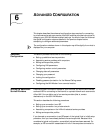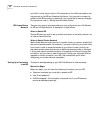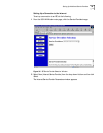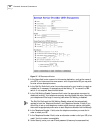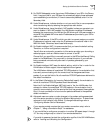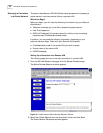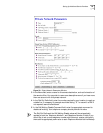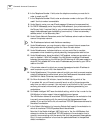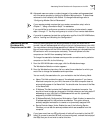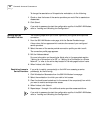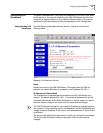
Setting Up Additional Service Providers 61
9 For DNS IP Address(es), enter the primary DNS address of your ISP in the Primary
field, if required (that is, your ISP does not automatically supply these addresses
upon establishing a connection). If there is a secondary address, enter it in the
Secondary field.
10 Under Miscellaneous, indicate whether or not you would like to use compression
when transferring data by selecting the appropriate radio button.
11 Under Miscellaneous, leave the default, NAT enabled, unless you are certain you
want to disable it. With NAT enabled, the LAN Modem translates IP addresses
between the computers on the LAN and the ISP, allowing all LAN users access to a
single ISP. Only disable NAT when static IP addresses are provided by your ISP for
users on the LAN.
12 Under Miscellaneous, if the ISP to which you wish to connect assigns you a static
IP address and a subnet mask, enter the IP address and the subnet mask in the
WAN link fields. Otherwise, leave these fields empty.
13 For Enable Intelligent NAT, it is recommended that you leave the default setting.
Therefore, no further configuration is required.
Yes will allow an automatic connection to this service provider upon launching a
related program, such as a Web browser to connect to an ISP.
Choose No if you would like to manually connect to this ISP via the Manual Calling
screen in the WebWizard. You may want to choose this option if your calls are
being connected unintentionally as a result of packets generated by your
workstations.
14 For Enable Intelligent NAT, leave the default setting, which is Yes, in order for the
LAN Modem to better support Internet applications and games.
The LAN Modem delivers all unsolicited TCP/UDP packets to the workstation that
is currently communicating with the remote host that has generated these
packets. If you set this field to No, all unsolicited TCP/UDP packets are delivered to
the default workstation.
15 In the Default Workstation for Incoming Packets field, specify the workstation to
which all unsolicited TCP/UDP packets should be delivered.
Note that if the Enable Intelligent NAT field is set to Yes, the LAN Modem first
attempts to deliver the unsolicited TCP/UDP packets to the workstation that is
currently communicating with the remote host that has generated these packets.
Only if no such workstation is found are the packets delivered to the specified
default workstation.
16 Advanced users can review or make changes to the modem settings associated
with this service provider by clicking the Modem Settings button. To leave these
values set to their defaults, click Submit. To change these settings, refer to
“Configuring Modem Control Parameters”.
If your service provider requires that you create a connection script, refer to
Chapter 7, “Using a Connection Script” for assistance.
If you would like to configure a connection to another ISP, repeat steps 1 through
16. You may configure up to a total of four remote destinations.
If you wish to password protect the configuration profile of the 56K LAN Modem,
refer to “Locking and Unlocking the Configuration.”







